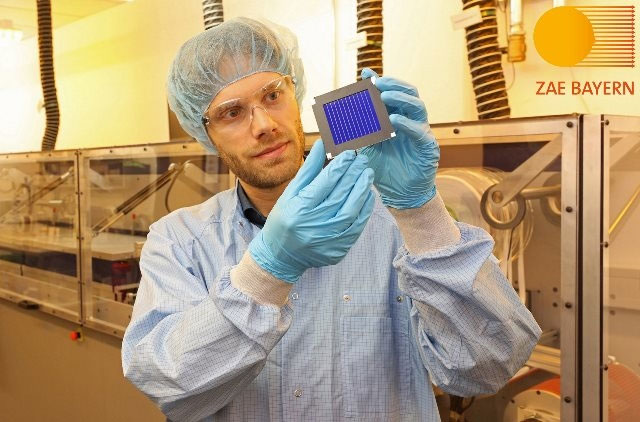Organic solar cells set a new world record for performance
A research team from Germany and China has set a new record of the energy conversion efficiency of organic photovoltaic modules (OPV) at 12.6% over an area of 26 cm2.
Scientists from Friedrichifer Alexander Erlangen-Nürnberg University (FAU, Germany), Applied Energy Research Center (ZAE) of Bavaria, Germany and Helmholtz Erlangen-Nürnberg Renewable Energy Institute (HI ERN), a branch of Forschungszentrum Jülich (German Helmholtz Association of German Research Centers), in collaboration with South China University of Technology (SCUT) designed an OPV module with an efficiency of 12.6% over an area of 26cm 2 , exceeding 30% of performance compared to the previous world record of 9.7%.

Dr. Andreas Distler, ZAE Bayern, with organic solar modules at the Solar Factory of the Future Center.
This is the highest efficiency value ever recorded for an organic photovoltaic module. It was confirmed by certified calibration measurements under standard test conditions of the Fraunhofer ISE independent certification laboratory (Freiburg) in September 1919. The multicellular module was developed at the Solar Factory Center of the Future at the Nürnberg Energy Research Facility (EnCN) in a coating laboratory with a megawatt test program. unique to thin film photovoltaics, designed and implemented with financial support from the Bavarian Ministry of Economic Affairs (Germany).
This breakthrough shows that Bavaria is not only a leader in the advancement of photovoltaic installations, but also a leading position in the development of future technologies, said Hubert Aiwanger, Minister of Economy. , Bavaria's Regional and Energy Development highlights.
Organic solar cells usually consist of two different organic components, possessing the necessary semiconductor properties. In contrast to the commonly used silicon, which is produced by energy-intensive melting processes, organic materials can be put directly onto films or glass to store them.
On the one hand, this helps to reduce production costs, on the other hand, the use of flexible, lightweight materials allows the implementation of many new applications, such as mobile devices or clothing, even if the efficiency is not comparable. comparable to traditional silicon solar cells.
According to Professor Christoph Brabec, FAU University, Director of the HI ERN Institute, and the Scientific Director of the Solar Factory of the Future Center: 'This is an important milestone in the study of organic semiconductors showing developments. The latest performance with certified cell efficiencies above 16%, is no longer limited to a lab scale, but is ready to expand to a modular 'model level'.
With their design, the efficiency of the fully assembled photovoltaic modules is always slightly lower than that of individual cells. For example, part of the module area is always inactive because it is used to connect individual cells. As the module area increases, so does the resistance of the electrode.
The recognition module consists of twelve cells connected sequentially and has a geometric fill factor of more than 95%. In this part of the module area positively contributes to electricity generation. As for its operating area, the module even achieved an efficiency of 13.2%. Reduction of inactive areas has been achieved through high-resolution laser structure, developed and optimized in recent years at 'Solar Factory of the Future'.
- How does a solar cell work?
- Ultra-thin solar battery system, which can be attached to any surface with tape only
- Successfully made solar cells from plants
- Japan develops washable solar cells like clothes
- Research to increase photovoltaic battery performance
- Method to increase solar cell performance
- Organic resins increase the efficiency of solar cells
- Sanyo prepares mass production of HIT Solar batteries
- Green Leaf - a source of inspiration for solar cells
- Solar cells have many advantages so why is not yet widely used?
- Solar cells will be usable at night
- Record of solar power efficiency
- Sunseeker Duo - 2-seater solar plane
- Solar car set a world record
 The US company is about to build a supersonic passenger plane of 6,000km / h
The US company is about to build a supersonic passenger plane of 6,000km / h Japan develops avatar robot as in fiction film
Japan develops avatar robot as in fiction film Australia tested the world's first mango picking robot
Australia tested the world's first mango picking robot America develops technology to separate water from animal waste
America develops technology to separate water from animal waste